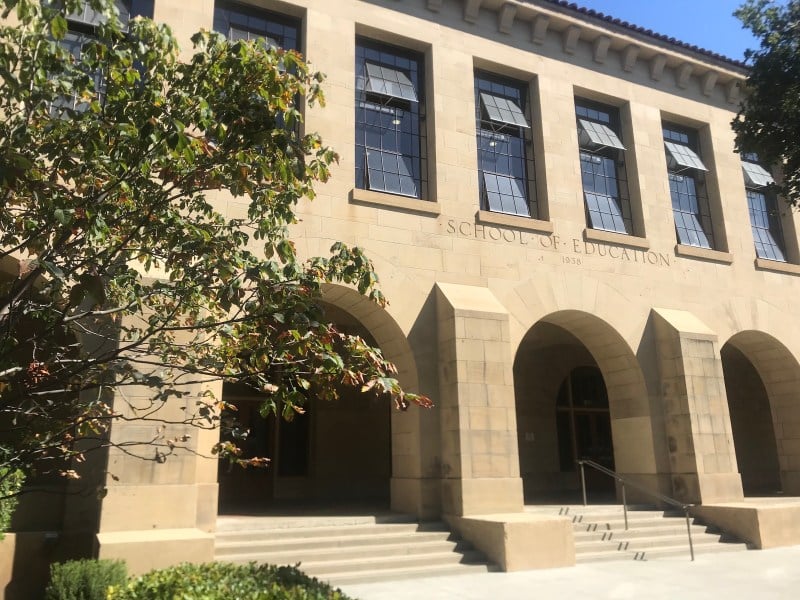Last June, 89 students moved from across the United States and abroad to join Stanford’s renowned Teacher Education Program (STEP) in the Graduate School of Education (GSE). Coming to Stanford was a dream for many of us. Many left behind families, partners and jobs in order to embark on this journey.
From our first day, we were greeted with care and dedication from the STEP faculty. Over the past months, we have learned about the conversations, research and literature surrounding education in the United States, focusing on issues of systemic inequalities for marginalized communities. We received extensive training on supporting students with special needs, supporting students who are English language learners and supporting diversity and inclusion throughout the profession. This experience has been tremendously impactful. It has shaped us as educators and researchers who are dedicated to social-justice pedagogies. But this quarter, due to COVID-19, this valuable preparation will not continue at the same level.
We believe that all Stanford programs should reduce spring tuition in response to COVID-19 and the impact it has had on the holistic experience of being a Stanford student. Education online is not education in person. As educators, we know this. Community building and professional networking are simply not the same online. The Stanford community knows this, which is why there are several petitions from students with hundreds of signatures calling on the University to take action. In a recent call with GSE deans, GSE students were told that if we continue to request tuition reimbursements, we will cost Stanford workers, specifically those “doing manual labor,” their jobs. This is highly problematic, as it implies that cutting low paid and vulnerable staff is the only option that Stanford has in addressing reimbursement requests. This is misleading, as there are other areas in which cost savings can be made that don’t jeopardize existing obligations to contractors or employees.
As STEP students, we see the expectation that we pay full tuition for Spring quarter as a contradiction to core tenets of our program. By design, “STEP integrates a high quality academic program with a well-supported, yearlong classroom placement.” Our fieldwork involves student teaching where we spend 16-20 hours a week at school sites and attend a weekly Seminar at Stanford that is designed to support our growth. As the STEP handbook states,
“The purpose of student teaching occurring concurrently with university coursework is to allow teacher candidates the opportunity to construct bridges between theory and practice. Teacher candidates spend time in schools and classrooms observing and practicing different approaches to teaching and learning. They experience the rhythms of a day, week, semester, and ultimately the year as they develop relationships with students, school faculty, parents/families, and others involved in the work of the school. Carefully chosen settings with expert cooperating teachers support the candidates’ growth and development as novice teachers.”
California schools will be closed until May, if not for the remainder of the school year. Thus, the structure of STEP and the level of our preparation have been greatly compromised. While some of us will get the opportunity to innovate and support students online, many of us have seen 20 hours of weekly teaching placements reduced to minimal or no teaching time.
While we recognize the programmatic losses of all Stanford programs, our purpose is to communicate and highlight the particular losses of the STEP program this spring. In the recent meeting with GSE deans, it was clear to us that Stanford leadership was not fully aware of the particular losses to our program.
With this in mind, we insist that:
- Stanford reimburse STEP students the cost of 5 units ($5,685)
- 2 units for a partial reimbursement of our Seminar class, the core of teaching placement support.
- The equivalent of 3 units for our student teaching placements, a modest reimbursement for 20 hours a week of lost in-person teaching experience, integrated coursework, and 3-4 observation cycles with our clinical supervisors that we will no longer be able to complete.
Many at Stanford are focused on identifying the opportunities and recovery that we have ahead of us. We are committed to this as well and plan to work diligently with STEP and with the schools we are placed in to find ways to connect, sustain, and grow community. We all feel the impact during this difficult time, and our thoughts are with those most affected.
This is a pivotal moment in higher education. Stanford must uphold the value of the unique educational experiences they provide. This is an opportunity to innovate and collaboratively design ways to support students and compensate for lost opportunities. From our first day in STEP, we were encouraged to advocate for the professionalism of our careers. To recognize the inherent value of the design of STEP and its core components, you must reimburse students that do not receive them in full.
Sincerely,
Luis Daniel Gonzalez, GSE ’20
Kelsey Larson, GSE ’20
Maggie Imboden, GSE ’20
Matthew Lin, GSE ’20
Michelle Reed, GSE ’20
Rita Jajjo, GSE ’20
This article is informed by the experiences and concerns of many STEP candidates.
